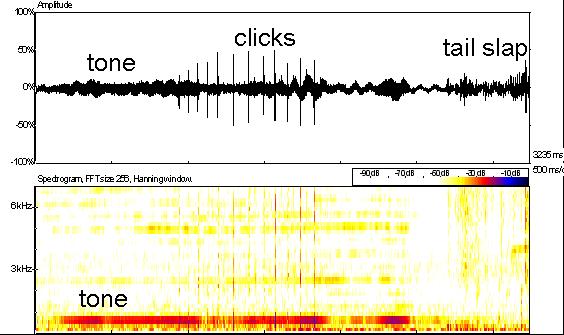151st ASA Meeting, Providence, RI
Killer Whales and Herring: Using Sound to Get a Meal
Lee A. Miller (lee@biology.sdu.dk),
Popular version of paper 4aAO2
Norwegian and Icelandic killer whales use a variety of techniques to get their dinner, many of which are acoustic. In defense, their prey employ clever acoustical countermeasures of their own. Icelandic killer whales, as we have discovered, employ an additional strategy, apparently not shared by their Norwegian cousins, that may give them an extra advantage in capturing their prey. Killer whales of the Northeast Atlantic feed primarily on herring. In Norwegian waters billions of herring migrate from open oceanic waters into deep fjords in the late fall to over winter. Here they form vast schools that move up and down in the water column in daily rhythms waiting for spring to approach. In February, they migrate about 1,000 km south to their spawning grounds, and then out to open waters again. Groups of killer whales follow the herring to cooperatively feed on this favored prey. Often the whales dive to over a hundred meters to drive herring up to shallower waters forcing the fish into tight groups by swimming around them and flashing their white bellies at them. During this process the whales emit a cacophony of sounds (echolocation clicks, click bursts, and whistles), some of which may help to tighten the herring school or coordinate whale movements. At the right moment individual whales swim into the herd of fish and perform underwater tail slaps that produce thud-like sounds and strong local water currents. Many fish turn belly-up and remain motionless, apparently stunned by the tail slap. Whales swim leisurely to the stunned fish and consume these one by one.
What actually stuns the herring? We can only speculate at present, but the thud-like sound produces an intense, bubble-producing (cavitation) pulse that may act like a blow from a hammer. Rapid water movements may disorient the fish or the whales tail may actually hit some fish. In any case some fish regain their orientation sense and swim away normally after a few minutes. Are the herring defenseless? Perhaps not: The swim bladder in fish is gas-filled and helps to maintain neutral buoyancy and in herring it is connected to the intestine. Herring forced toward the surface by a flock of killer whales can release air from the anus producing a curtain of tiny bubbles around the school. This bubble curtain can act as a screen for the whales sonar clicks causing the school to suddenly disappear and perhaps thwarting attack. In vernacular, "farting" may save their lives. Icelandic killer whales may have refined their techniques for capturing herring. They too use underwater tail slaps like their Norwegian relatives. The tail slaps have only been heard and the consequences remain to be filmed although stunned herring rise to the water surface above where whales are feeding. When listening to sequences of underwater tail slaps from Icelandic killer whales we heard a long (about 3 seconds) tonal sound (about 680 Hz) just prior (about 0.3 seconds) to the thud in about half of the tail slaps (see picture 3 and listen to the sound). We never heard such tonal sounds in the tail slaps of Norwegian killer whales.
What could be the function of these tones? Could they communicate to other killer whales that a slap was pending? We do not think so because the main energy in the tone is below frequencies that the whales can hear well. Can herring hear the tone? The swim bladder of the herring is connected to the inner ear, making hearing in this fish very sensitive. Furthermore. the best hearing frequency of herring is around 700 Hz, or the resonant frequency of the swim bladder at depths where they are preyed upon. So the herring can certainly hear the tone produced by the killer whale. What effect could the tone have on the herring? The killer whale tone is very intense (170 to 190 dB at a distance of 1 m and a reference pressure of 1 microPascal) and could force the school of herring to form a tighter ball making the tail slap more effective by stunning more fish than otherwise possible Therefore, North Atlantic killer whales -- and their herring targets -- make abundant use of acoustics in their roles as predator and prey. Some references:
|


